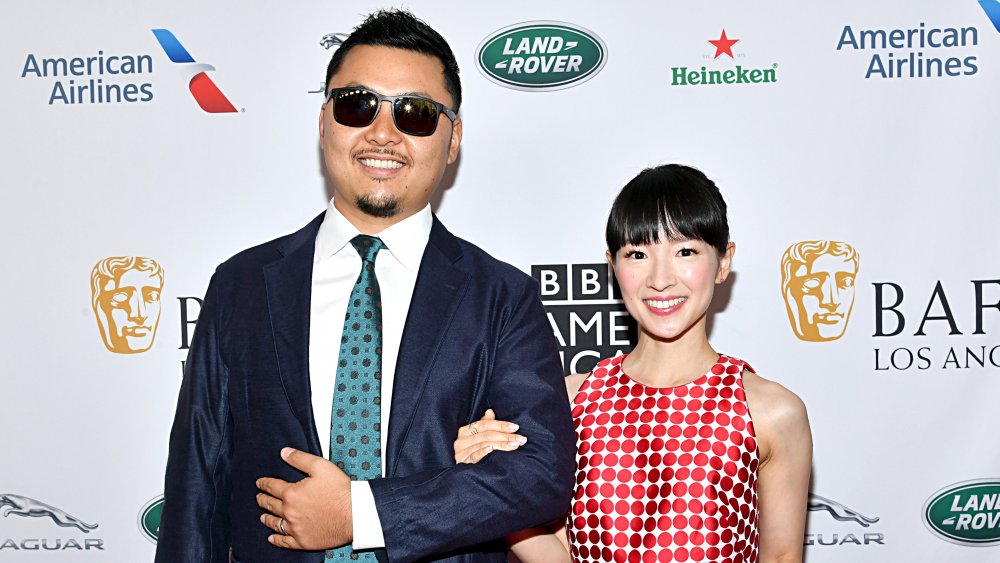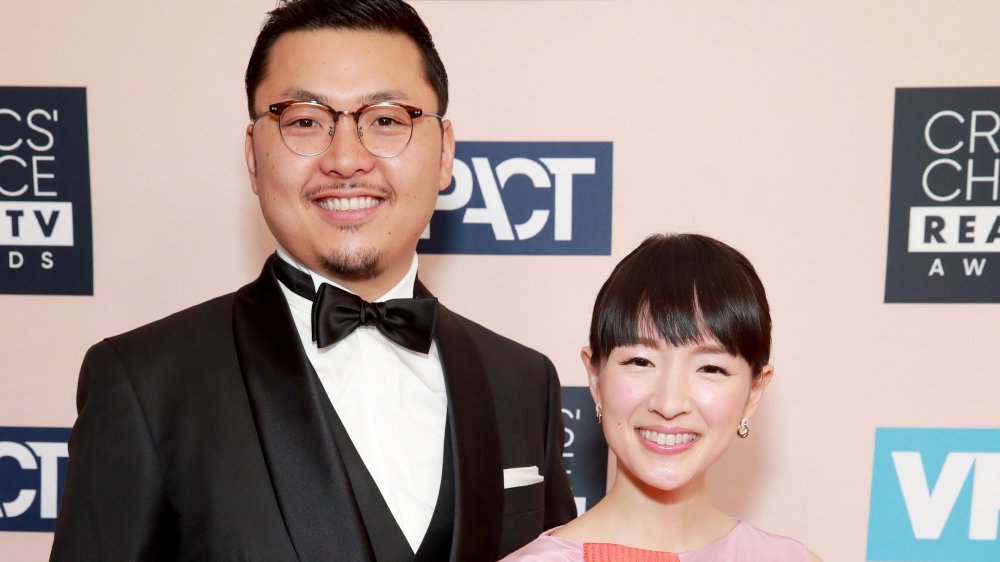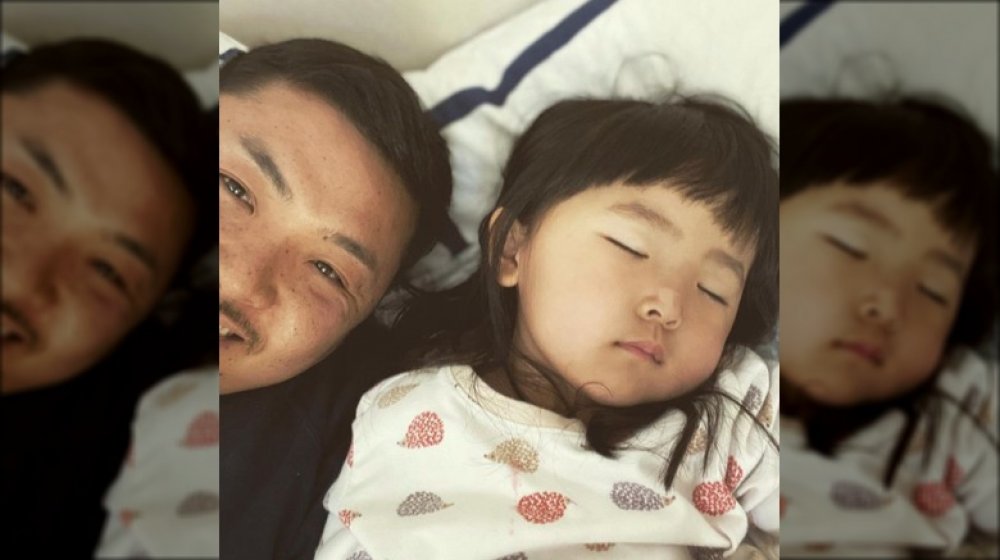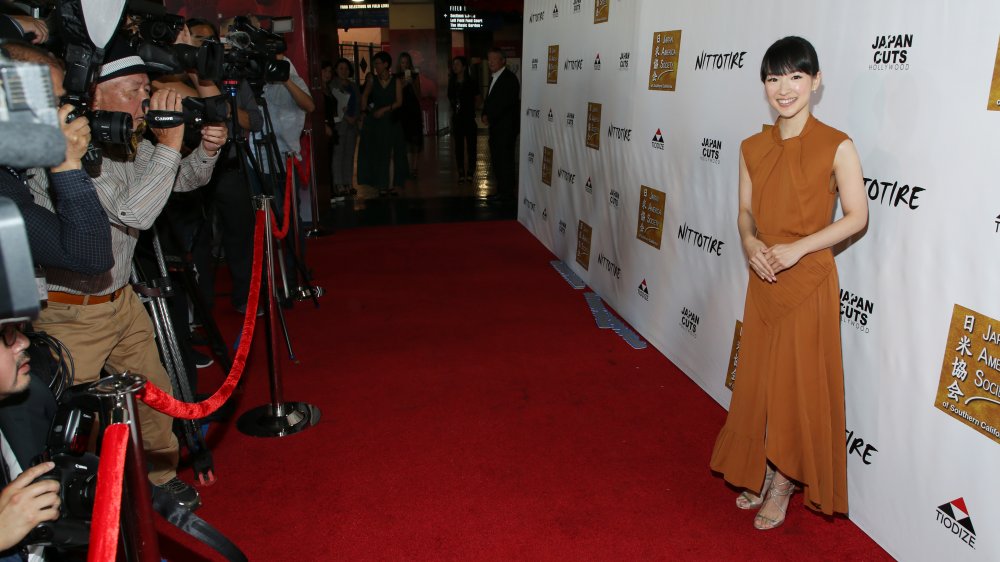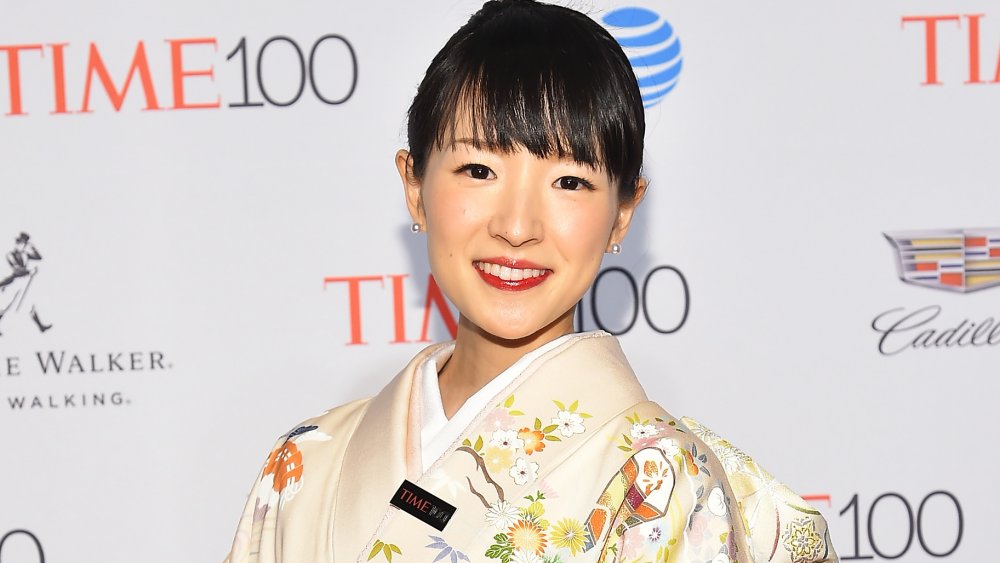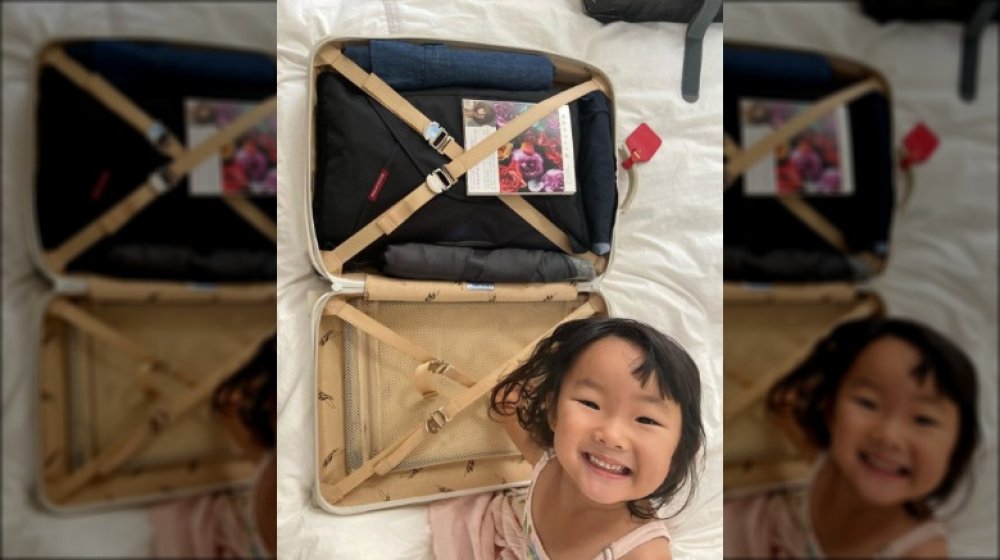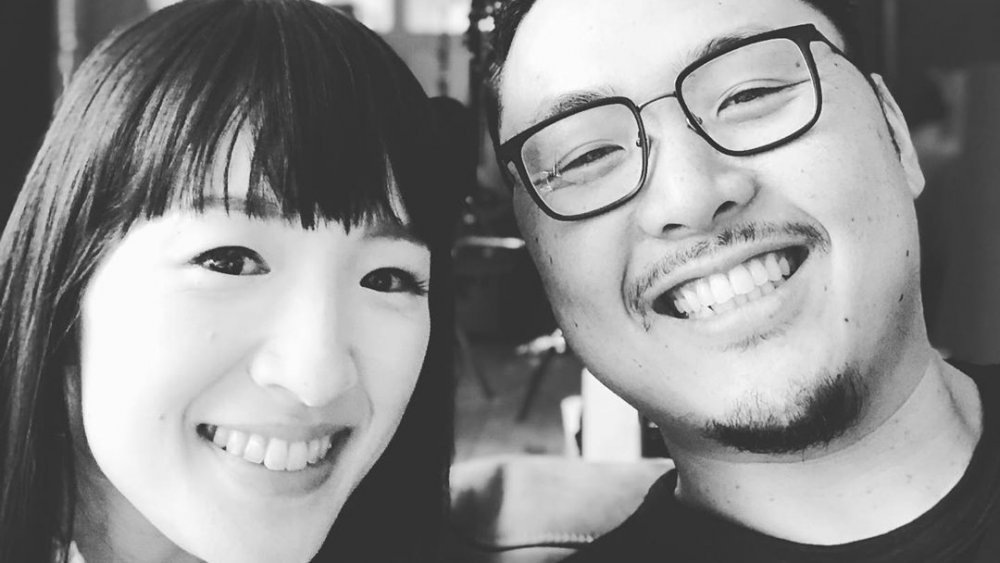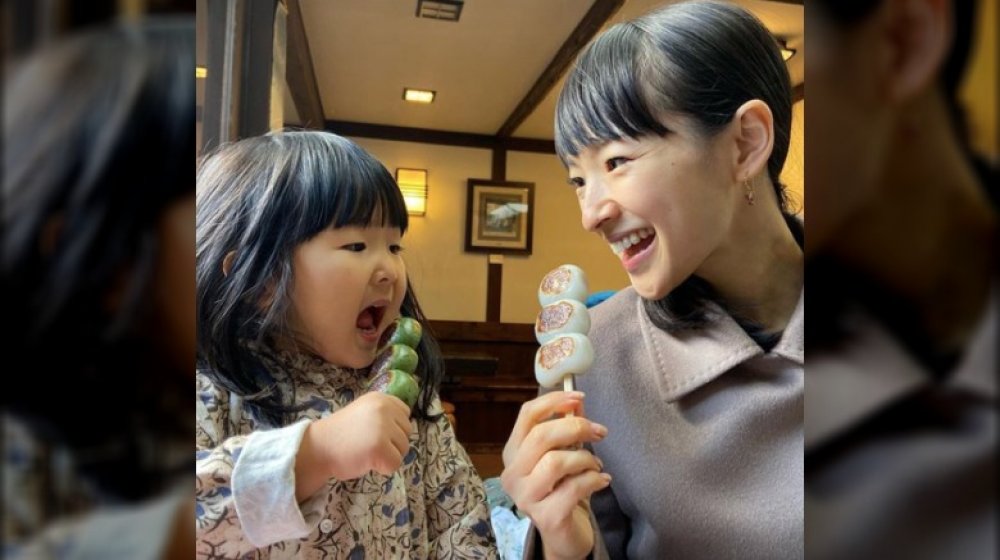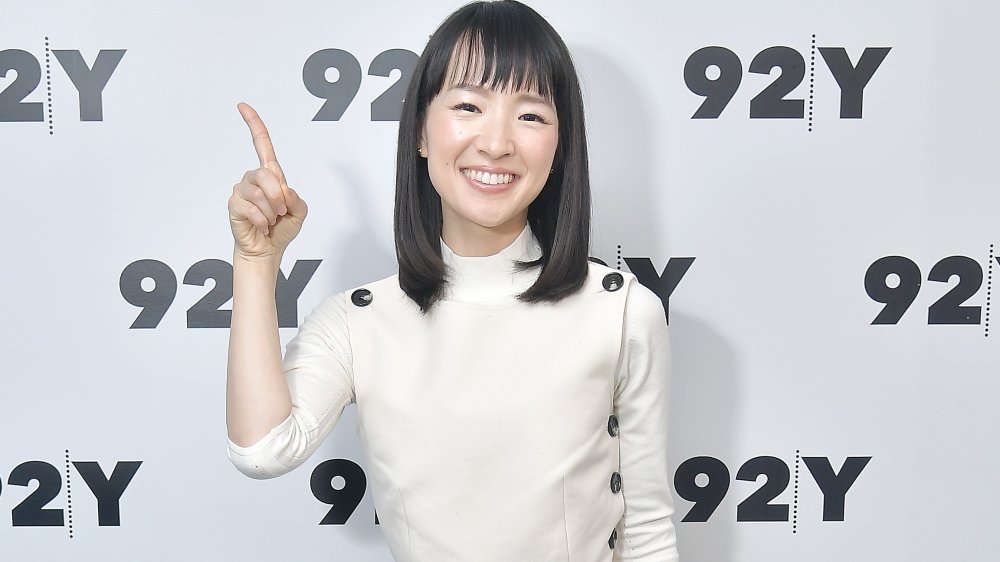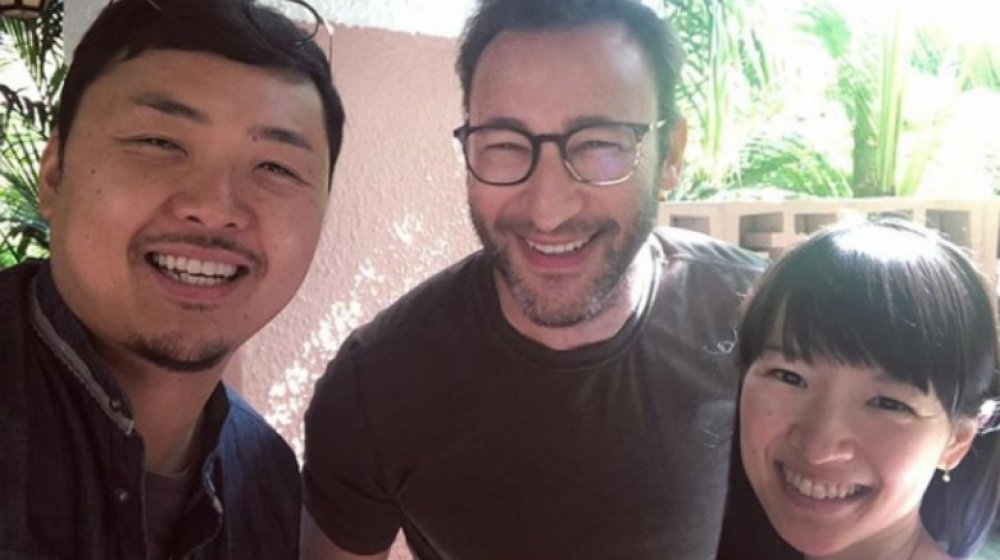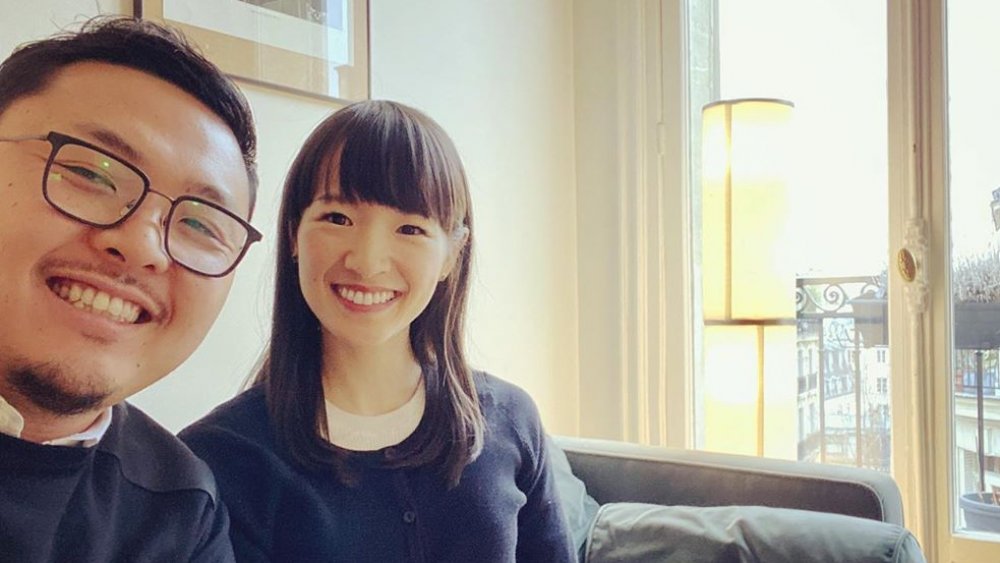Weird Things About Marie Kondo's Marriage
We may receive a commission on purchases made from links.
In 2014, Japanese decluttering guru, author, and television star Marie Kondo released her book The Life Changing-Magic of Tidying Up in the United States. Since then, we have brazenly vowed to declutter every aspect of our lives, removing everything that doesn't spark joy — from shoes and keepsakes to gifts and even boyfriends. In the words of Kiki Palmer, sorry to this man. Okay, maybe telling our roommates that we won't take out the garbage because it doesn't spark joy is taking it a bit too far, but what can we say? We're obsessed.
Though the celeb may be behind the most popular Netflix nonfiction series of 2019, Tidying Up With Marie Kondo, she didn't rise to the top alone. The star's husband Takumi Kawahara has been at her side since before she became a New York Times best-selling author. Unlike many of the A-list couples that came before them, Kondo's marriage is devoid of scandal. In fact, the strangest thing about the pair — who share two young daughters — is how well they seem to get along. Who would have thought?
Marie Kondo met her husband years before she got famous
Hollywood doesn't exactly breed long-lasting relationships. Marriages seem to happen overnight and dissolve just as quickly (see: Carmen Electra and her quickie 1998 elopement to Dennis Rodman or Britney Spears and her famous 55-hour marriage to a childhood pal). Marie Kondo and Takumi Kawahara seemingly break the cycle, as the queen of tidying up met her king years before they tied the knot.
According to a profile by Fast Company, Kondo and Kawahara first met in an elevator when they were 21-year-old college students. She noticed him because he had a badge clipped to his suit that read "dream" in Japanese. "When I saw that, I thought, what a passionate person!" she told the outlet. She gave Kawahara her business card, but they didn't reconnect until years later after Kondo's book The Life-Changing Magic of Tidying Up became a success in Japan following the 2011 earthquake.
In a rather serendipitous twist of fate, Kawahara, who was working in human resources when Kondo first tried to reconnect, had no idea that the author had become famous. As it turns out, he had completely tidied the pop culture out of his life. "I had organized my home so much that I didn't own a TV set, so I had no idea," he told Fast Company. The pair married in 2014 (though some reports say 2012) and moved from Japan to the San Francisco Bay Area two years later.
Takumi Kawahara gave up his career for Marie Kondo
It looks like Marie Kondo got herself an Instagram husband — except multiply that by 100. Takumi Kawahara doesn't just take pictures of his wife for social media; he helps her in every facet of her business. In fact, the father of two gave up his career to help Kondo follow her dreams.
According to Good Housekeeping, the businessman was working a corporate job "in sales support and marketing" when he decided to quit and become Marie Kondo's manager. Fast Company reports that the pair co-founded the company KonMari Media in 2015 — the year after they wed — and Kawahara took over as CEO. Now he hangs out behind the scenes securing book deals, producing Kondo's Netflix series, and accompanying her on photoshoots. "We're always talking about work, even in our private moments," Kawahara told Fast Company. "She was an author who was very good at transmitting a message to the world. I was good at creating businesses and establishing networks."
Though quitting his job and going all-in on Kondo's career was a risk, it certainly paid off. According to Fast Company, the $12 billion Japanese e-commerce behemoth Rakuten acquired a majority stake in KonMari Media in August 2019. This, they report, is roughly the equivalent of Amazon buying out Gwyneth Paltrow's Goop. Actually, in Japan, it's even better. Unlike Amazon, Rakuten "owns banks and mortgage brokerage services."
Marie Kondo needs some help coping with the cameras
Marie Kondo's personality is slightly at odds with her stardom. The author is naturally introverted, which seems like a contradiction for someone with more than 3.7 million Instagram followers. In short: the spotlight doesn't necessarily spark joy for the tidying-up guru, but Kondo has to do it, especially after her monster 2019 year.
According to Fast Company, Kondo kicked off the year with the launch of her first Netflix series, Tidying Up With Marie Kondo, which quickly became the platform's most-watched nonfiction program of 2019. By the end of the year, she had expanded her network of consultants to 40 different countries and launched a brand new e-commerce site, peddling things like a $75 tuning fork or $22 face brush that'd rival anything on the sometimes-shady Goop. "I have to be a public figure so I can spread this message," she explained to Fast Company. "But it's much harder for me than for people who naturally excel at being in front of a lot of people. Takumi has really helped me."
Kawahara has a specific method for making Kondo more comfortable in front of the cameras. According to the outlet, he's "the life of the set" and eases Kondo's nerves by "making funny faces, telling jokes, and putting everyone at ease." He's the yin to her yang. "Even though Takumi's more extroverted and I'm much more introspective, we're the same on the inside," Kondo gushed to Fast Company.
Takumi Kawahara didn't need to put a ring on it
Marie Kondo may have an estimated net worth of around $8 million, but the tidying-up guru wasn't always well-off. Before the Rakuten acquisition, the best sellers, and the Netflix show, Kondo's husband couldn't scrape together enough money to buy her an engagement ring — but love prevails, brand new diamond or not. In a blog post on her website, Kondo explained that she ended up wearing her grandmother's ring, which was given to her when she passed away, instead of buying a new one. After all, it's not the diamond that sparks joy. Hopefully, it's the husband.
"When Takumi, my husband, proposed to me, he didn't have the money to buy me a ring," she wrote. "I told him, 'I don't need a ring! You can give me this ring instead.' Her ring is the one he gave to me when he proposed."
Kondo's entire philosophy is firmly anti-acquisition, and she regularly pushes against buying stuff for the sake of buying stuff. According to The Atlantic, the idea of a diamond engagement ring is just that: buying stuff because someone said we have to. The entire tradition was created by an ad campaign, and Kondo doesn't need it.
They planned their married lifestyle on a spreadsheet
Most of us love a good Google or Excel spreadsheet, but at work – not for fun. You couldn't pay us enough to use it in our off time, but then again, we're not all Marie Kondo and Takumi Kawahara. For the couple, spreadsheets do, indeed, spark much joy. In fact, they're more or less an integral part of their marriage.
In an interview with The Cut, Kondo revealed that she and Kawahara basically negotiated the terms of their married lifestyle via spreadsheet right after they tied the knot. "We sat down and talked about the kind of home life we wanted and what it would take to achieve that. We put all of this on a shared Google spreadsheet," she said. "When one of us completed a task, we'd mark it as done and then the other one might leave a message saying 'Thank you,' or something like that. It was all very systematic."
It's unclear if they dove deep into who gets the TV remote or who could please stop putting dry-cleaning in the hamper with the rest of the dirty laundry, but they've managed to shift from the master Google spreadsheet to a shared online calendar, which seems daringly loose in comparison.
Two peas in a meticulously organized pod
Marie Kondo appears to have truly found her person. While most of us are busy arguing with our spouses about leaving their gym socks all over the floor, Takumi Kawahara was already hyper-organized before he met the tidying-up guru. "He was able to clean and be very organized even before he read my book, but it was certainly even more pronounced after he read my book," Kondo told Good Housekeeping in 2016. "He became even more efficient. Fundamentally speaking, we're in the same groove."
The pair seem to be completely in sync with their anti-clutter values, and this was never more clear than when they were preparing to have their first child. During this time, most parents are acquiring a ton of stuff — from cribs and clothes to changing tables and a stockpile of diapers — but Kondo and Kawahara used the opportunity to have what Kondo described to The Wall Street Journal as a "decluttering festival." As she went on to explain, "By creating clear boundaries for the children's things ... they made it easier to decide how much was too much."
Even their kids are tidy machines
Marie Kondo planned to teach her daughters — Satsuki and Miko — the Konmari Method once they turned three years old, but do you really think the spawn of two of the tidiest parents on the planet actually needed help? It was already running through their veins. In an interview with The Wall Street Journal, Kondo revealed that her kids started tidying up before she showed them the ropes.
"I was surprised to see [Satsuki] putting books, stuffed animals, and toys for playing house back in their place more precisely than I expected," Kondo explained. "She is also trying to copy me folding clothes, though I secretly fix them when she's not looking."
Unfortunately, kids are kids. They're still learning. There's no way they're going to be able to do a vertical t-shirt fold as perfect as their mom. "Of course they're not up to my level," Kondo told The Cut. "They're still young and I just have to accept that they will clutter things for the time being." Yes, even Kondo and Kawahara have to put up with clutter every once in a while. No one is immune to the mess of kids.
Bless Marie Kondo's mess
After Marie Kondo got married, she had to accept that her lifestyle was going to be a little bit different. Her married life hasn't always been as tidy as she hoped (says all of us staring at our partner's collection of half-filled water glasses that have been vacationing on the nightstand for a week). Allowing a mess was a bitter pill, but once Kondo swallowed it, she learned a great lesson in letting go and was no longer held down by the shackles of immaculate organization. Seriously, how many hours a day did she get back?
In an interview with Better Homes & Gardens, Kondo admitted, "To be honest, my situation has changed since I was single. I've let go of needing to maintain a perfect home all the time." Letting go of your partner's mess is actually one of Kondo's principles. The author told Good Housekeeping that you should always focus on your own items before you drag family members into it — and you have to respect their stuff, even if it pains you.
"In regards to things your husband loves, even if you hate that item, you cannot disregard them without his permission," she said, adding, "You don't need to force yourself to love those items, but you can accept them into your life." Unfortunately, accepting your partner means accepting their mess, too.
Household tasks are split right down the middle
If the newlywed spreadsheet wasn't enough of a tip-off, Marie Kondo and Takumi Kawahara split household duties like they're on a factory line. While most of us are arguing about who's turn it is to make the bed or pick up the kids, these lovebird business partners are complete relationship goals. In an interview with The Cut, Kondo revealed, "We have a very clear division of labor at home. My husband is in charge of the cooking and I'm in charge of the cleaning. So my husband will do breakfast and I'll put the dishes in the dishwasher, put things away, set and clear the table."
Kondo and Kawahara know their strengths and use them to their advantage. Of course Kondo is the one in charge of the cleaning. There are few people who can tidy with such fervor, but Kawahara also happens to be a great cook. Kondo told The Cut that he usually makes her a "Japanese-style breakfast, with rice, miso soup, dried radish, and fermented soybeans" — at least on days when they're not pressed for time. In that case, they grab some toast or a piece of fruit. Easy!
The one habit Marie Kondo took from her single life
Most of us retain negative habits from our single lives, like trolling through Tinder at two in the morning because we're bored. That's just because none of us are Marie Kondo. The one major habit she retained from her single life helps her connect with the world around her (and not just faceless six packs on a cell phone screen).
According to The New Yorker, Kondo "was an assistant at a Shinto shrine" before finding success as a best-selling author and organizational consultant. She kept up with the practice at home, telling The Cut that she maintains a Japanese-style kamidana (or Shinto altar) on a shelf with some salt, rice, and evergreen fronds. Every morning, she refreshes the altar and says some prayers before starting her day.
"I'll pray for the health of my family and friends, and also for myself to get done as much as possible what needs to be done," she told The Cut. "This is not a religious thing really at all. It's just for me to take this time every morning to feel gratitude. It's a practice I started when I was still single, maybe about seven years ago." It's true: we could all use a little more gratitude when our alarm clocks shock us awake at the crack of dawn. Kondo, on the other hand, wakes up naturally around six or 6:30 am. When the powers of cleanliness call, she answers.
Marie Kondo and Takumi Kawahara struggled with their Netflix series
Marie Kondo's Netflix series Tidying Up With Marie Kondo undeniably made her a crossover hit in the United States, but that doesn't mean it was smooth sailing. She and her husband both struggled with this significant shift in energy. According to Fast Company, the pair had brushes with TV fame before their series premiered in 2019. Kondo's book had already been transformed into a Japanese drama, NBC ordered (and scrapped) a potential sitcom, Kondo even had a two-part special called Tidy Up With KonMari on a network in Japan. It wasn't until Gail Berman, the producer behind NBC's failed sitcom, pitched Tidying Up to Amazon and Netflix that the series was secured. Netflix won the deal by ordering an entire series right out of the gate.
Despite the success, Kondo told Fast Company that she "wasn't used to the process" of making a series and became "really physically exhausted." Takumi Kawahara agreed, claiming that the series "became a source of enormous stress" to his wife, and the pair "struggled to maintain" a healthy work-life balance. Netflix tried to make things easier for the struggling star by modifying the production schedule to give her time off-set, but she was still sitting on the offer for Season 2, which should've been a no-brainer. Ultimately, the author decided to return to the streaming giant with a new show called Sparking Joy with Marie Kondo, which has a focus on small-town America.
The one piece of clutter Marie Kondo and Takumi Kawahara let slide
It's hard to imagine Marie Kondo keeping anything in her house that doesn't serve a distinct purpose. After all, the woman believes a purse should be emptied out every single day (tell that to the mint floating around our grandma's bag since 1995). Sometimes, though, we all give in to our vices — and Takumi Kawahara had no qualms about sharing his wife's dark secret with the world. In an interview with Good Housekeeping, the businessman reminded Kondo that she does, in fact, have a "secret deviance" from her typical clutter-free home: a stuffed seal. Kondo immediately started laughing. "It's very small. It was a gift from my father, and even though I'm an adult, I still keep it on my shelf. It's something I can't part with," she sheepishly admitted.
Kondo also revealed that she owns just one random t-shirt, which was free swag from a 2005 expo, and for some reason, she can't let it go even though she prefers prettier loungewear. "This T-shirt sticks out like a sore thumb among all my graceful, feminine clothes," she revealed. Hey, if it sparks joy, it sparks joy, right?

